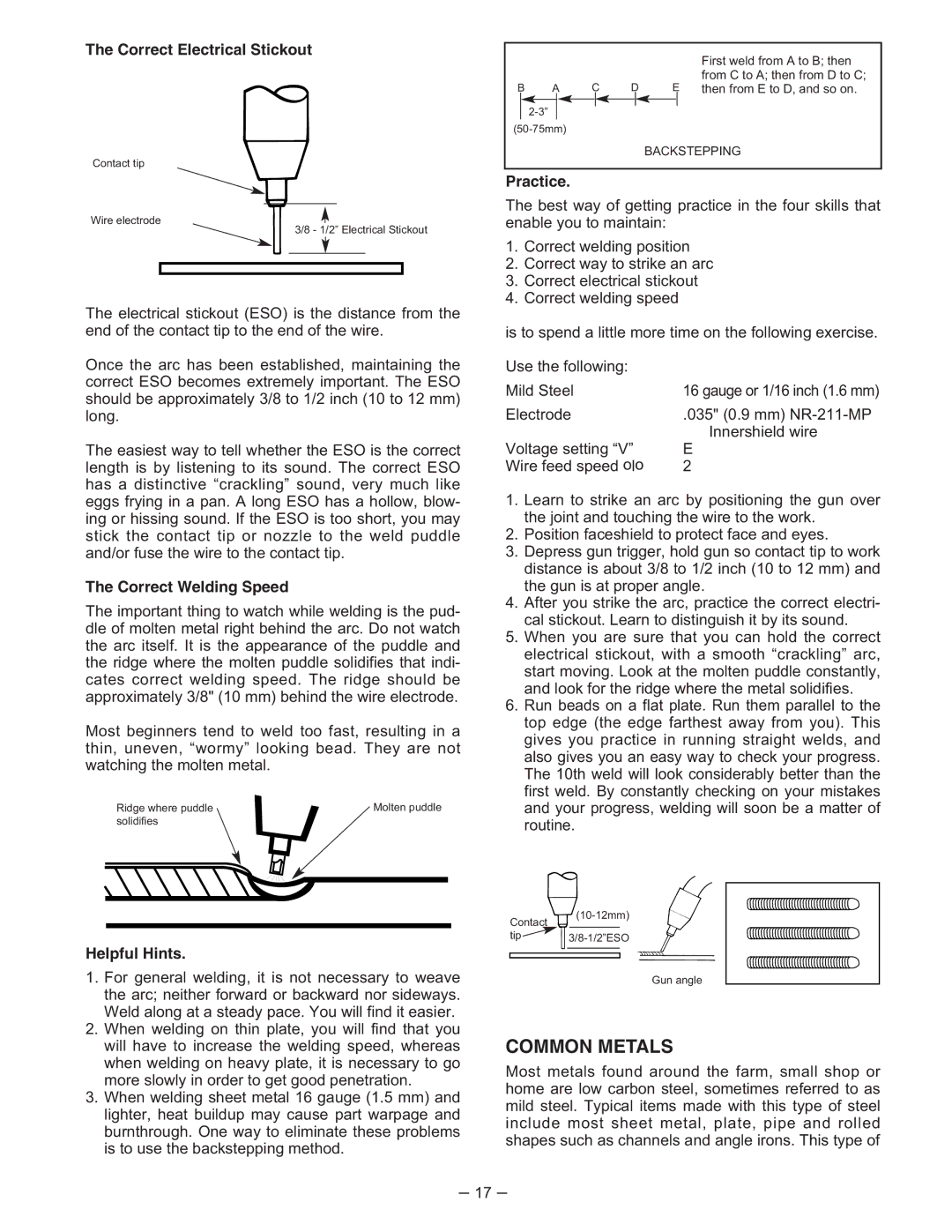
The Correct Electrical Stickout
Contact tip
Wire electrode
3/8 - 1/2” Electrical Stickout
The electrical stickout (ESO) is the distance from the end of the contact tip to the end of the wire.
Once the arc has been established, maintaining the correct ESO becomes extremely important. The ESO should be approximately 3/8 to 1/2 inch (10 to 12 mm) long.
The easiest way to tell whether the ESO is the correct length is by listening to its sound. The correct ESO has a distinctive “crackling” sound, very much like eggs frying in a pan. A long ESO has a hollow, blow- ing or hissing sound. If the ESO is too short, you may stick the contact tip or nozzle to the weld puddle and/or fuse the wire to the contact tip.
The Correct Welding Speed
The important thing to watch while welding is the pud- dle of molten metal right behind the arc. Do not watch the arc itself. It is the appearance of the puddle and the ridge where the molten puddle solidifies that indi- cates correct welding speed. The ridge should be approximately 3/8" (10 mm) behind the wire electrode.
Most beginners tend to weld too fast, resulting in a thin, uneven, “wormy” looking bead. They are not watching the molten metal.
Ridge where puddle | Molten puddle |
| |
solidifies |
|
| |
|
|
|
|
|
|
|
|
|
|
|
|
|
|
|
|
|
|
|
|
|
|
|
|
Helpful Hints.
1.For general welding, it is not necessary to weave the arc; neither forward or backward nor sideways. Weld along at a steady pace. You will find it easier.
2.When welding on thin plate, you will find that you will have to increase the welding speed, whereas when welding on heavy plate, it is necessary to go more slowly in order to get good penetration.
3.When welding sheet metal 16 gauge (1.5 mm) and lighter, heat buildup may cause part warpage and burnthrough. One way to eliminate these problems is to use the backstepping method.
|
|
|
|
|
|
|
|
|
|
|
|
|
|
|
| First weld from A to B; then |
|
|
|
|
|
|
|
|
|
|
|
|
|
|
|
| from C to A; then from D to C; |
B |
| A |
|
| C |
|
| D |
|
| E |
| then from E to D, and so on. | |||
|
|
|
|
|
|
|
|
|
|
|
|
|
|
|
|
|
|
|
|
|
|
|
|
|
|
|
|
|
|
|
|
|
|
|
|
|
|
|
|
|
|
|
|
|
|
|
|
|
|
|
BACKSTEPPING
Practice.
The best way of getting practice in the four skills that enable you to maintain:
1.Correct welding position
2.Correct way to strike an arc
3.Correct electrical stickout
4.Correct welding speed
is to spend a little more time on the following exercise.
Use the following: |
|
Mild Steel | 16 gauge or 1/16 inch (1.6 mm) |
Electrode | .035" (0.9 mm) |
| Innershield wire |
Voltage setting “V” | E |
Wire feed speed olo | 2 |
1.Learn to strike an arc by positioning the gun over the joint and touching the wire to the work.
2.Position faceshield to protect face and eyes.
3.Depress gun trigger, hold gun so contact tip to work distance is about 3/8 to 1/2 inch (10 to 12 mm) and the gun is at proper angle.
4.After you strike the arc, practice the correct electri- cal stickout. Learn to distinguish it by its sound.
5.When you are sure that you can hold the correct electrical stickout, with a smooth “crackling” arc, start moving. Look at the molten puddle constantly, and look for the ridge where the metal solidifies.
6.Run beads on a flat plate. Run them parallel to the top edge (the edge farthest away from you). This gives you practice in running straight welds, and also gives you an easy way to check your progress. The 10th weld will look considerably better than the first weld. By constantly checking on your mistakes and your progress, welding will soon be a matter of routine.
![]() (10-12mm)
(10-12mm)![]()
tip![]()
Gun angle
COMMON METALS
Most metals found around the farm, small shop or home are low carbon steel, sometimes referred to as mild steel. Typical items made with this type of steel include most sheet metal, plate, pipe and rolled shapes such as channels and angle irons. This type of
– 17 –
